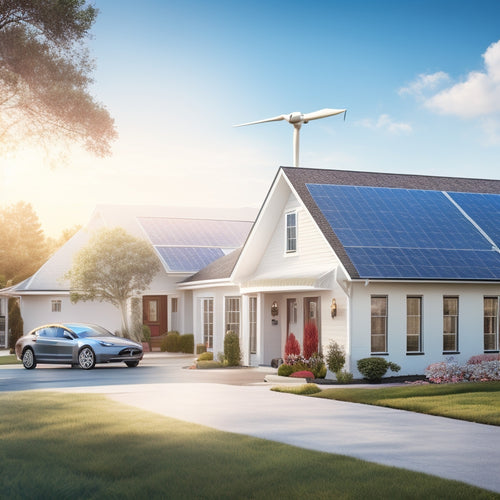
What's the True Cost of Solar Panel Ownership?
Share
As a solar panel owner, you'll face ongoing expenses beyond the initial installation cost. Warranties, maintenance, and repair costs can add up quickly if not properly managed. Regular inspections, cleaning, and inverter replacements will be necessary to guarantee peak performance. You'll need to factor in debris removal, energy audits, and potential repair costs into your budget. By understanding the true cost of solar panel ownership, you can make informed decisions to optimize your investment. From maintenance strategies to extended warranty options, there's more to learn about minimizing costs and maximizing your solar panel's potential.
Key Takeaways
• Solar panel warranties can impact overall ownership costs, with reputable manufacturers offering longer warranty periods and better customer support.
• Regular maintenance, including inspections and cleaning, is crucial for peak performance and can help prevent costly repairs.
• Inverter quality and installation can significantly affect replacement costs, with high-quality inverters potentially reducing costs.
• System downtime due to equipment failure can result in lost revenue and efficiency, emphasizing the importance of proactive monitoring and maintenance.
• Extended warranties can provide an added layer of security against equipment failures and repairs, safeguarding your investment in solar panels.
Understanding Solar Panel Warranties
When you invest in a solar panel system, understanding the warranty that comes with it's important, as it can greatly impact your overall cost of ownership. A thorough warranty can provide peace of mind and protect your investment.
You should look for a manufacturer with a proven track record of reliability, as a reliable manufacturer is more likely to stand behind their product. Manufacturer reliability is vital, as it directly affects the quality of the warranty.
A reputable manufacturer will typically offer a longer warranty period, often 25 years or more, and will be more likely to honor claims. Additionally, a reliable manufacturer will provide better customer support, making it easier to resolve any issues that may arise.
Warranty transferability is another crucial aspect to take into account. If you plan to sell your property in the future, a transferable warranty can increase the value of your property. Look for manufacturers that offer transferable warranties, allowing the new owner to benefit from the remaining warranty period.
Average Cost of Solar Panel Maintenance
As you consider the average cost of solar panel maintenance, you'll need to factor in regular inspections to make sure your system is running efficiently.
You'll also need to account for the importance of regular panel cleaning, which can greatly impact energy production.
Additionally, you'll want to prepare for potential repair and replacement costs, which can arise from wear and tear or unexpected damage.
Regular Inspection Needs
Maintaining your solar panel system requires regular inspections to guarantee peak performance, and you can expect to pay around $100 to $300 per inspection, depending on the complexity of the system and the provider's rates.
The inspection frequency will vary depending on your system's size, age, and performance, but as a general rule, it's recommended to have your system inspected every 6-12 months.
During these inspections, professionals will check for signs of wear and tear, verify that safety protocols are in place, and make sure that your system is operating at best levels.
These inspections are essential in identifying potential issues before they become major problems, which can help prevent costly repairs down the line. Additionally, regular inspections can help you identify opportunities to optimize your system's performance, which can lead to increased energy production and savings on your utility bills.
Panel Cleaning Importance
You'll need to budget for regular panel cleaning, an important aspect of solar panel maintenance, to make sure your system operates at maximum efficiency and generates the most electricity possible. Dust accumulation can lead to a significant decrease in energy production, so regular cleaning is essential. In fact, a study found that dirty panels can reduce energy output by up to 25%.
| Frequency | Method | Cost |
|---|---|---|
| Weekly | Automated cleaning systems | $500 - $1,000 |
| Monthly | Manual cleaning with water | $100 - $300 |
| Quarterly | Manual cleaning with water-conserving solutions | $200 - $500 |
| Bi-annually | Professional cleaning services | $300 - $600 |
| Annually | Thorough system inspection and cleaning | $500 - $1,000 |
Repair and Replacement Costs
On average, you can expect to spend between $1,000 to $3,000 on repair and replacement costs over the lifespan of your solar panel system, depending on the type and quality of your equipment. This includes replacing inverters, which can cost around $1,000 to $2,000, as well as repairing or replacing damaged or faulty panels. Battery degradation is another factor to take into account, as batteries may need to be replaced every 10 to 15 years, adding to the overall maintenance cost.
When it comes to parts sourcing, it's important to verify that replacement parts are compatible with your system to avoid any potential issues. Additionally, it's crucial to bear in mind that labor costs can add up quickly, especially if you hire a professional to perform the repairs.
To minimize costs, it's recommended to perform routine maintenance tasks, such as cleaning and inspecting your system, to identify potential issues before they become major problems. By budgeting for these expenses, you can ensure that your solar panel system continues to operate efficiently and effectively over its lifespan.
Inverter Replacement Cost Factors
Several factors, including the inverter's original quality, installation quality, and environmental conditions, greatly influence the cost of replacing your solar panel inverter. You'll want to take these factors into account to get an accurate estimate of the replacement cost.
A high-quality inverter, for instance, may last longer and require less maintenance, reducing the overall replacement cost. On the other hand, a low-quality inverter may need to be replaced more frequently, increasing the cost. The installation quality also plays a significant role, as a poorly installed inverter may lead to premature failure, resulting in additional costs.
Environmental conditions, such as extreme temperatures, humidity, and exposure to salt air, can also impact the inverter's lifespan and replacement cost. If you're considering an inverter upgrade, you may want to explore power optimization options to maximize your energy output.
Cleaning and Inspection Expenses
As you consider the costs of owning solar panels, you'll need to factor in the expenses associated with keeping them clean and well-maintained. Regular cleaning and inspections are essential to guarantee maximum energy production, and you'll need to decide on a maintenance schedule that works for you.
The frequency and cost of these services will depend on factors like debris removal, inspection frequency, and the specific needs of your system.
Regular Maintenance Schedules
You'll need to budget for regular maintenance schedules, which typically include cleaning and inspection expenses to guarantee peak solar panel performance. These routine checks are vital to make sure your system operates at its best levels, maximizing energy production and reducing the risk of damage.
As a solar panel owner, you should consider conducting energy audits to identify areas of improvement and implement preventative measures to minimize potential issues. This proactive approach can help you avoid costly repairs down the line.
Regular maintenance schedules typically involve inspecting the system for signs of wear and tear, cleaning the panels to remove dirt and debris, and verifying that all components are functioning correctly. This maintenance is essential to maintain the system's efficiency and extend its lifespan.
Debris Removal Costs
Regular cleaning and inspection of your solar panels are necessary to maintain peak energy production. This process comes with costs that need to be factored into your budget. You'll need to take into account the cost of hiring professionals to clean your panels, especially if you have a large solar array or if you're not comfortable with heights.
Additionally, you may need to budget for tree trimming services to prevent branches from obstructing sunlight or causing damage to your panels. Storm damage can also lead to unexpected cleaning and repair costs, which should be included in your budget. On average, you can expect to pay between $100 to $300 per year for cleaning and inspection services, depending on the frequency and type of services needed.
It's important to research local service providers and compare prices to find the best deal for your solar panel maintenance needs. By budgeting for these expenses, you can ensure that your solar panels operate efficiently and maximize your energy production.
Frequency of Inspections
Determining the frequency of inspections is crucial for maintaining peak solar panel performance. It's important to establish a schedule that balances cleaning and inspection expenses with energy production goals. You'll want to take into account factors like climate, pollution, and vegetation growth to determine the ideal inspection cycle for your solar panels.
Regular inspections can help you:
- Identify potential issues before they impact energy production
- Optimize panel performance and energy output
- Extend the lifespan of your solar panels
When setting your inspection schedule, take into consideration the following maintenance intervals:
- Monthly visual inspections to identify debris or damage
- Quarterly inspections to check for loose connections or worn components
- Annual inspections to perform thorough cleaning and maintenance tasks
Repairing Solar Panel Damage
When your solar panel system sustains damage, prompt repair is important to minimize energy losses and prevent further deterioration. Delaying repairs can lead to reduced energy output, decreased system lifespan, and even safety hazards. As a solar panel owner, it's vital to address damage promptly to guarantee peak performance.
Damage Assessment and Repair Costs
| Type of Damage | Average Repair Cost |
|---|---|
| Broken or cracked panels | $200-$500 per panel |
| Loose or corroded connections | $100-$300 per connection |
| Inverter failure | $1,000-$3,000 |
When evaluating damage, it's crucial to identify the root cause to prevent future occurrences. Panel refurbishment may be necessary to restore your system to its best performance. A thorough damage assessment will help you determine the best course of action and provide a detailed estimate of repair costs. By addressing damage promptly, you can minimize energy losses and ensure your solar panel system operates effectively.
Monitoring System Failure Costs
What's the real cost of a monitoring system failure, and how can you mitigate it? As a solar panel owner, you rely on your monitoring system to track your energy production and identify potential issues. But when it fails, you're left in the dark. Literally.
A monitoring system failure can lead to:
-
System downtime: Without real-time data, you can't optimize your energy production, resulting in lost revenue and reduced efficiency.
-
Battery drain: If your system isn't monitored, your batteries may not be charging or discharging correctly, leading to reduced lifespan and increased maintenance costs.
-
Increased maintenance costs: When issues go undetected, they can escalate into more severe problems, resulting in costly repairs and replacements.
To mitigate these costs, consider investing in a redundant monitoring system or regular maintenance checks to identify potential issues before they become major problems. By being proactive, you can minimize system downtime, reduce battery drain, and avoid costly repairs.
Don't let a monitoring system failure catch you off guard – take control of your solar panel system today.
Inverter Efficiency Degradation
To guarantee system uptime and minimize maintenance costs, another potential pitfall to be aware of is inverter efficiency degradation, which can silently chip away at your solar panel system's performance. This sneaky issue can lead to significant energy loss over time, ultimately reducing your system's overall energy output.
Inverter efficiency degradation occurs when the inverter, which converts DC power from your solar panels to AC power for your home, loses its ability to operate at peak efficiency. This can be caused by a variety of factors, including heat, humidity, and component wear. If left unchecked, inverter efficiency degradation can lead to inverter failure, resulting in costly repairs or even complete system shutdown.
To mitigate this risk, monitoring your system's performance regularly and addressing any issues promptly is crucial. By staying on top of inverter efficiency, you can minimize energy loss and ensure your solar panel system operates at its best.
Extended Warranty Options
You can safeguard your investment in solar panels with extended warranty options, which provide an added layer of security against equipment failures and performance degradation. These warranties can provide peace of mind, as they cover repairs and replacements for a specified period.
When selecting an extended warranty, consider the following key factors:
-
Warranty Providers: Research reputable warranty providers that specialize in solar panel systems. Look for providers with a proven track record of honoring claims and offering flexible policy options.
-
Policy Flexibility: Opt for a warranty that offers flexible policy terms, including customizable coverage periods and deductible options. This guarantees you can tailor the warranty to your specific needs and budget.
-
Additional Benefits: Some warranties may include additional benefits, such as monitoring and maintenance services, which can help prevent equipment failures and optimize system performance.
Frequently Asked Questions
Can I Install Solar Panels on a Metal or Clay Tile Roof?
You'll need to assess your roof's condition before installing solar panels on a metal or clay tile roof, considering roof preparation, potential tile removal, metal strength, and overall roof durability to guarantee a secure and efficient installation.
Will Solar Panels Still Work During a Power Outage?
"Your solar panels are like a sleeping beauty, dormant during a power outage, unless you have a backup system in place, like a battery storage system, which can provide emergency power, keeping your lights on during the darkest hours."
Can I Finance Solar Panels With a Home Equity Loan?
You can finance solar panels with a home equity loan, but be aware that interest rates, loan terms, and credit scores impact your approval and repayment terms, while your home's equity value determines the loan amount.
Are Solar Panels Affected by Shade From Trees or Buildings?
"Shedding light on your concerns, you'll find that solar panels are indeed affected by shade from trees or buildings, especially when the tree canopy is dense or your roof orientation is less than ideal."
Do Solar Panels Increase My Property Value?
You'll likely see an appraisal boost, as solar panels increase your property's resale value, making it more attractive to potential buyers and potentially boosting your sale price.
Related Posts
-

Charging Points in Rural Areas: 5 Key Insights
When driving through rural areas, you'll face a shortage of charging points, making EV ownership stressful and inconv...
-

Why Homeowners Are Embracing DIY Energy Independence
By taking control of your energy needs, you're breaking free from the uncertainty of utility bills and embracing a se...
-

Why Cities Need Smart Charging Infrastructure Now
You're about to experience a tidal wave of electric vehicles hitting your city's streets, and it's essential you're p...


